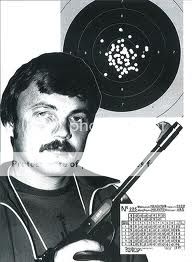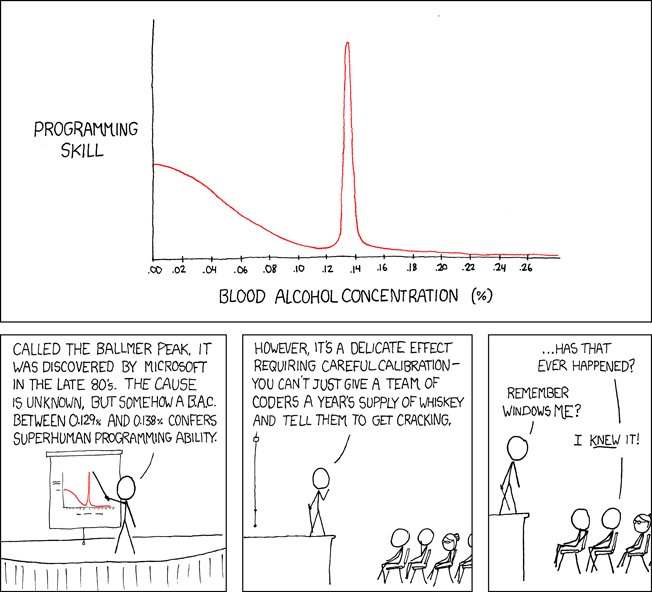Part 1: How accurate is Good?
I define good shooting as the proper execution of fundamentals [essentially] 100% of the time. Fundamentals are, as I am certain you have read elsewhere: a balanced stance, a firm grip, and proper sight alignment with a good sight picture. Most importantly, good shooting requires a great trigger press which allows the gun to fire without disturbing the good sight picture. I found that Fundamental Accuracy is a 4” group at 7 yards.
Many years ago I placed my Glock 34 on a rest and fired 5 specific groups of shots. In the first group I fired with the sights properly aligned. As a result I placed three shots into the center of the target in a sub one inch group. Next, I intentionally moved the front sight in the rear sight notch so that it appeared to touch the inside edge of the rear sight notch’s left wall. The shots were 2” to the left. Then I shot the opposite. I moved the front sight so that it appeared to touch the inside edge of the rear sight notch’s right wall. The shots were 2” to the right. When I centered the front sight in the notch but intentionally deviated the front sight about the same distance high and low as I had left and right, I got shots which were 2” high and low. From this I deduced that any shot within a 4” circle is fundamentally sound if we accept that keeping the front sight in the notch of the rear sight with the rear sight nearly centered on the target is fundamentally sound. This 4” group represents a minimum standard- one in which you are shooting without any gross error. You cannot claim to be a good shooter until you are fundamentally sound. I said, good, not great, because clearly better shooting is possible.
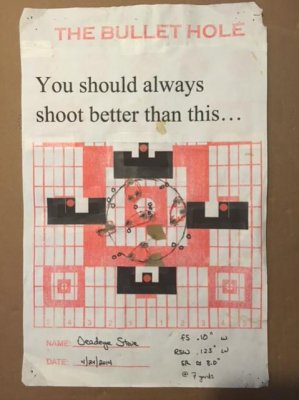
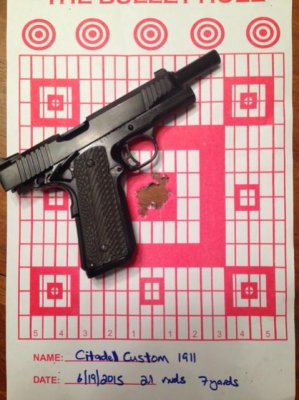
I don’t consider a group good for myself unless it approaches 1” at 7 yards; 4” at 7 yards is simply a minimum standard. Once you can hold every shot in a 4” circle I expect you will note a large majority of your shots landing inside 3” with but a few shots closer to the line describing your 4” diameter. I suspect you will quickly set a goal to hold all of your shots in that 3” circle. With a little more practice most of your shots are landing in a neat 2” groups with a few in a 3” diameter and almost none outside that. Again, you will likely set a goal to hold that 2” group with 100% of your shots. Should that seem challenging to you and say, your M&P Shield as opposed to my Glock 34, I would respond that it is OK; the standard is scalable and adaptable.
It’s adaptable to your gun. Were you to do the same sighting arrangements as I and found a larger or smaller group (based on sights, sight radius, inherent gun accuracy, etc.) then use that group size as your fundamental accuracy. It is scalable to distance. Using my group size of 4” at 7 yards, if you’re at 5 yards, fundamentally sound shooting is akin to 2.85” ((distance/7)*group size). At 10 yards it’s 5.7” inches ((distance/7)*group size). It will also serve to identify your improvement over fundamentally accurate. Should you prove yourself capable of shooting 2” groups at 7 yards you are 50% better than fundamentally sound. A 2” group at 15 yards is about 76% better than fundamentally accurate. I predict, however, you will quickly begin to tire of just shooting small groups. I know that I did, and we all recognize that “speed” is a skill, too.
I regularly play games wherein I try to see how fast I can shoot and keep all shots touching a 2” square. I also use the 4” standard to see how fast I can shoot and not fail at fundamentals. You no doubt noticed that did not share how fast that was. In Part 2, I will share how fast I think is “good.”
I define good shooting as the proper execution of fundamentals [essentially] 100% of the time. Fundamentals are, as I am certain you have read elsewhere: a balanced stance, a firm grip, and proper sight alignment with a good sight picture. Most importantly, good shooting requires a great trigger press which allows the gun to fire without disturbing the good sight picture. I found that Fundamental Accuracy is a 4” group at 7 yards.
Many years ago I placed my Glock 34 on a rest and fired 5 specific groups of shots. In the first group I fired with the sights properly aligned. As a result I placed three shots into the center of the target in a sub one inch group. Next, I intentionally moved the front sight in the rear sight notch so that it appeared to touch the inside edge of the rear sight notch’s left wall. The shots were 2” to the left. Then I shot the opposite. I moved the front sight so that it appeared to touch the inside edge of the rear sight notch’s right wall. The shots were 2” to the right. When I centered the front sight in the notch but intentionally deviated the front sight about the same distance high and low as I had left and right, I got shots which were 2” high and low. From this I deduced that any shot within a 4” circle is fundamentally sound if we accept that keeping the front sight in the notch of the rear sight with the rear sight nearly centered on the target is fundamentally sound. This 4” group represents a minimum standard- one in which you are shooting without any gross error. You cannot claim to be a good shooter until you are fundamentally sound. I said, good, not great, because clearly better shooting is possible.


I don’t consider a group good for myself unless it approaches 1” at 7 yards; 4” at 7 yards is simply a minimum standard. Once you can hold every shot in a 4” circle I expect you will note a large majority of your shots landing inside 3” with but a few shots closer to the line describing your 4” diameter. I suspect you will quickly set a goal to hold all of your shots in that 3” circle. With a little more practice most of your shots are landing in a neat 2” groups with a few in a 3” diameter and almost none outside that. Again, you will likely set a goal to hold that 2” group with 100% of your shots. Should that seem challenging to you and say, your M&P Shield as opposed to my Glock 34, I would respond that it is OK; the standard is scalable and adaptable.
It’s adaptable to your gun. Were you to do the same sighting arrangements as I and found a larger or smaller group (based on sights, sight radius, inherent gun accuracy, etc.) then use that group size as your fundamental accuracy. It is scalable to distance. Using my group size of 4” at 7 yards, if you’re at 5 yards, fundamentally sound shooting is akin to 2.85” ((distance/7)*group size). At 10 yards it’s 5.7” inches ((distance/7)*group size). It will also serve to identify your improvement over fundamentally accurate. Should you prove yourself capable of shooting 2” groups at 7 yards you are 50% better than fundamentally sound. A 2” group at 15 yards is about 76% better than fundamentally accurate. I predict, however, you will quickly begin to tire of just shooting small groups. I know that I did, and we all recognize that “speed” is a skill, too.
I regularly play games wherein I try to see how fast I can shoot and keep all shots touching a 2” square. I also use the 4” standard to see how fast I can shoot and not fail at fundamentals. You no doubt noticed that did not share how fast that was. In Part 2, I will share how fast I think is “good.”
Attachments
Last edited:



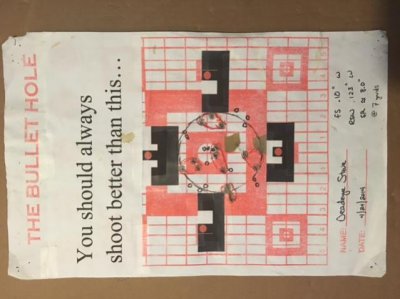
 , etc...
, etc...